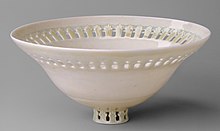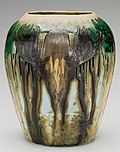art.wikisort.org - Artist
Adelaide Alsop Robineau (1865–1929) was an American china painter and potter, and is considered one of the top ceramists of American art pottery in her era.[1][2][3]
Early life and education
Adelaide Alsop was born in 1865 in Middletown, Connecticut.[4] She developed an early interest in both drawing and the then–popular pursuit of china painting. As a young woman she helped to support her family by teaching drawing at the boarding school where she had formerly been a student.[5] During one summer break, she enrolled in the painter William Merritt Chase's summer school, her only experience of advanced training in painting and drawing.[5] She later studied ceramics with Charles Binns at Alfred University and with Taxile Doat.[6]
In 1899, she married Samuel E. Robineau, a French ceramics expert who was at one time editor of Old China magazine.[5][6] The couple had three children.[6]
Pottery

In 1899, Robineau and her husband launched Keramic Studio, a periodical for potters and ceramic artists that continued in print until 1919.[6] Within a few years, Robineau became the magazine's sole editor.[5] Around the same time, the couple moved to Syracuse, New York, where their house was designed by architect Katharine Budd. Robineau later built a ceramic studio next to the house. She taught china painting and pottery at her Four Winds Pottery School and sold her painted china, watercolors, and ceramics.[5]
Robineau began seriously making ceramics around 1901, by which time she already had a reputation as a china painter.[5] She became convinced that painting over the glaze — then a common technique — was the wrong approach and began to experiment with other procedures.[5] She worked primarily in porcelain, experimenting with American clays to create a true high-fire porcelain.[5] She also experimented with a wide range of forms, decorations, and glazes, with frequent use of multicolored, opalescent, and iridescent glazes.[5] Her mature work shows Art Nouveau and Japonisme influences in the use of stylized botanical and animal elements.[5] At a time when many noted china painters worked with blanks made by other people, she handled all phases of the process herself, from forming the pots to incising and painting them.[6] Some of the detail work on her pieces was so fine that she employed crochet needles and dental tools to get the desired effect.[2]
Many of Robineau's works are containers, including her most famous work, the Scarab Vase, a tall, incised porcelain vase that took over 1000 hours to make.[6] In 2000, Art & Antiquities magazine named it the most important piece of American ceramics of the last hundred years.[1]
Robineau taught at both Syracuse University (1920–1929) and the Art Academy of People's University, an institution founded by Edward Gardner Lewis in Missouri.[6]
Before her death in 1929, she designed a cinerary urn that now holds the ashes of both Robineau and her husband in Syracuse, New York.[2][7]
Her work is in the collection of the Metropolitan Museum of Art, Everson Museum of Art,[8] Detroit Institute of Arts,[9] Cranbrook Art Museum,[7] and other institutions.
- Porcelain vase, c. 1905
- Vase with moose, c. 1907-08
- Group of porcelain vases at a 1913 Chicago Art Institute exhibition, with Scarab Vase at top center
- Bottle, 1926
- Vase, 1927
- Porcelain vase, 1928
References
- Tapp, Barbara S., ed. "Top Treasures of the Century." Art & Antiques special issue, March 2000.
- Kirst, Sean (May 13, 2006). "Adelaide Robineau, Syracuse ceramist: In her prime, 'best in the Western world'". Syracuse.com.
- Rago, David (2016-04-18). "Antiques Roadshow | PBS". Antiques Roadshow | PBS. Retrieved 2019-09-05.
Adelaide Alsop Robineau was arguably the most important single figure in early 20th-century decorative arts. Where most potters and potteries were working in earthenware, she explored the depths and redefined the heights of porcelain.
{{cite web}}: CS1 maint: url-status (link) - "Adelaide Alsop Robineau". Encyclopædia Britannica, 1911.
- Shrimpton, Louise (January 1910). "An Art Potter and Her Home". Good Housekeeping. Vol. 50, no. 1. pp. 57–63.
- Bell, Barbara Nicholson. "Adelaide Alsop Robineau, Master Ceramist". Syracuse Then and Now. Retrieved March 9, 2017.
- "Adelaide Alsop Robineau - A Collection of Thirty-Four Vases and Jars - 1909-28". Cranbrook Art Museum. Retrieved 2019-09-05.
Born 1865, Middletown, Connecticut; died 1929, Syracuse, New York
{{cite web}}: CS1 maint: url-status (link) - "Object of the Week: Adelaide Alsop Robineau's Scarab Vase". Everson Museum. 2018-01-18. Retrieved 2019-09-05.
{{cite web}}: CS1 maint: url-status (link) - "Adelaide Alsop Robineau, Indian Vase, 1913". www.dia.org. Retrieved 2019-09-05.
{{cite web}}: CS1 maint: url-status (link)
Further reading
- Weiss, Peg, ed. Adelaide Alsop Robineau: Glory in Porcelain. Syracuse University Press, 1981.
External links
 Media related to Adelaide Alsop Robineau at Wikimedia Commons
Media related to Adelaide Alsop Robineau at Wikimedia Commons- Complete digitized set of Keramic Studio, hosted by the Smithsonian Institution
- Missouri Remembers Artist Database
На других языках
- [en] Adelaide Alsop Robineau
[it] Adelaïde Alsop Robineau
Adelaïde Alsop Robineau (Middletown, 1865 – Syracuse, 1929) è stata una pittrice e ceramista statunitense, considerata ancora oggi una delle figure più rilevanti nella storia statunitense della ceramica del XX secolo.Другой контент может иметь иную лицензию. Перед использованием материалов сайта WikiSort.org внимательно изучите правила лицензирования конкретных элементов наполнения сайта.
WikiSort.org - проект по пересортировке и дополнению контента Википедии






